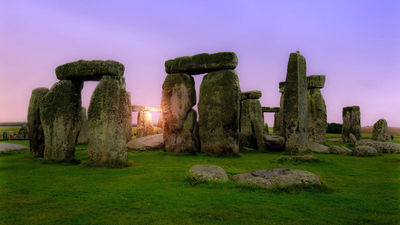The long-standing mystery of 'Where did the Stonehenge megalith come from?'

Origins of the sarsen megaliths at Stonehenge | Science Advances
https://advances.sciencemag.org/content/6/31/eabc0133
Stonehenge: how we revealed the original source of the biggest stones
https://theconversation.com/stonehenge-how-we-revealed-the-original-source-of-the-biggest-stones-143564

We Finally Know Where The Megaliths of Stonehenge Really Came From
Created by prehistoric people, Stonehenge is a popular tourist attraction that attracts millions of tourists annually and has been studied by scholars for hundreds of years. However, it seems that there are still many mysteries in Stonehenge, and the mystery of 'where did the huge stone used in Stonehenge come from?' remained unclear for four centuries.
It is known that the stone used in Stonehenge is not a single stone, but mainly two types of stone. One of which sandstone is ' Sarusen stone ', and the other one is igneous rocks consisting of sandstone ' Blue Stone is'.
Previous studies have shown that the horseshoe-shaped blue stones inside Stonehenge appear to have been quarried at Preseri Hills , approximately 290km northwest of Stonehenge. On the other hand, it was not known where the sarsenite, which is the symbol of Stonehenge in its upright combination, came from.
The structure of sarsenite that can be confirmed at the time of writing the article is said to have been built around 2500 BC, and there are 5 sets of structures with a height of about 7 m that support one megalith with two upright megaliths, and the diameter around it. A huge stone with a height of 4-5 m stands upright in a circle of about 100 m. In the morning of the summer solstice, the sun rises from Heel Stone, which is the entrance to Stonehenge, and the light reaches the altar stone in the center, so it is believed that the designer had knowledge of astronomy.

It is generally considered that Stonehenge's sarsenite came from the
A multidisciplinary team of researchers, including researchers at Brighton University , Bournemouth University , Reading University , and University College London , is investigating the origins of the sarsenite used in Stonehenge to explore a different geochemical I used a different approach.
The research team conducted a non-destructive method called Portable Fluorescent X-ray Spectroscopy (PXRF) on all existing sarsenes. The research team had to go as close as possible to Stonehenge, so the research team made a shift between night and early morning when Stonehenge was closed, and investigated the huge stone with a ladder.

PXRF analysis revealed that most of the stones in Stonehenge had a common chemical signature, with the exception of only two. This result suggests that the sarsene stones used in Stonehenge were not brought apart, but from a single location.
In addition, the research team lost the missing stone during the restoration work of Stonehenge in 1958, and
And when we compared the chemical features found in Stonehenge's sarsene with those of samples from 20 potential sarsene quarries, the match was found in the West , southwest of Marlborough. ・It was only Woods . From this result, the team concluded that Stonehenge's sarsene stones were mostly transported from West Woods.
The findings could help uncover archeological questions about the routes and methods by which people carried megaliths, said lead author David Nash. ``The construction of Stonehenge required a lot of work,'' said Nash, who spoke of the bluestone being shipped from farther places and the difficulty of carrying up to 30 tonnes of boulders. 'I think there was a very organized society there.'

by Andy Powell
Related Posts:
in Science, Posted by log1h_ik







